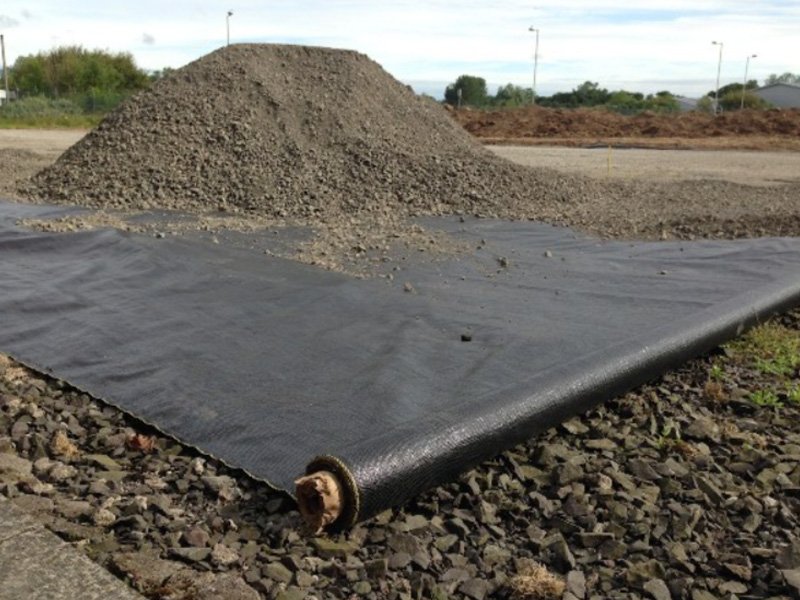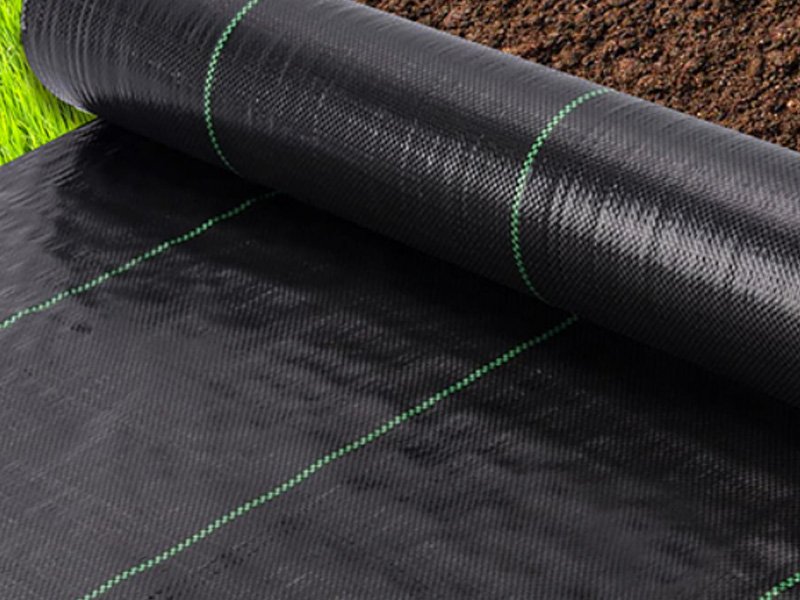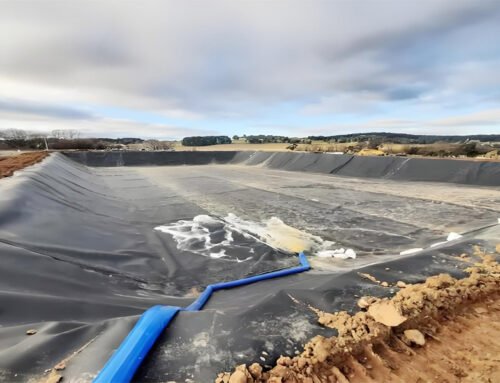Woven geotextile is flat, permeable textile structures created by weaving two or more sets of yarns or fibers together. Woven geotextiles are employed in conjunction with soil, rock, or other geotechnical materials as an essential component of human-made projects, structures, or systems.
The common two types of woven geotextiles are PET and PP woven geotextile. They are widely used for stabilizing construction entrances and staging areas, bridging over soft soils, separating dissimilar soils, reinforcing soil structures, controlling shoreline erosion, and constructing bulkheads.
With their ability to enhance soil stability, improve drainage, and provide strength to engineering projects, woven geotextiles serve as reliable and versatile tools in geotechnical engineering. Their permeability allows for proper water flow while maintaining the integrity of the surrounding materials.
As the leading geosynthetics manufacturer, GEOSINCERE offers a wide range of woven and non woven geotextile at best factory price. In this article, let us explore the what is woven geotextile and how to choose it.
1. What Is A Woven Geotextile?
Woven geotextile is a type of geotextile made from polypropylene yarns that are interwoven to create a stable and robust network, ensuring the yarns maintain their relative position.
This geotextile is specifically engineered with high tensile strength and low elongation, offering exceptional dimensional stability. It effectively distributes loads, reducing rutting and extending the lifespan of both paved and unpaved roadways.
Woven geotextile can allow water flow while maintaining its dimensional stability. This feature ensures proper drainage and prevents the accumulation of water, which can compromise the integrity of the construction.
Woven geotextile greatly enhances the overall performance and longevity of the infrastructure. Its robust construction provides reinforcement and stability, effectively managing stresses and strains exerted on the surface.
Woven geotextile is extensive used in various sectors such as road construction, driveways, railroads, sports fields, and more. Its high strength and durability make it an ideal choice for projects that require reliable stabilization, erosion control, and load distribution.
2. What Is A PP Woven Geotextile?
PP woven geotextile, or polypropylene woven geotextile, is a type of geosynthetic material specifically designed for use in various road construction applications. It is composed of fibrillated polypropylene yarns, which are woven together to form a strong and durable fabric.
PP woven geotextile provides separation and reinforcement in road construction projects. It acts as a barrier between different layers of soil or aggregate, preventing them from mixing and maintaining their individual integrity. This separation function helps to enhance the stability and performance of the road structure.
PP woven geotextile also serves other essential functions in construction. It acts as a filtration layer, allowing water to pass through while retaining soil particles. This helps to prevent clogging and maintain proper drainage within the road system. The geotextile also provides reinforcement by distributing loads and improving the overall strength of the construction.
PP woven geotextile offers protection to the underlying layers by preventing damage from punctures or abrasion. It acts as a barrier against sharp objects or stresses that could potentially compromise the road’s integrity.
PP woven geotextile is a versatile construction material with multiple functions, including separation, filtration, reinforcement, protection, and drainage. Its high strength and durability make it an effective solution for enhancing the performance and longevity of road constructions.


3. What Are Categories of Woven Geotextile?
There are three basic categories of woven geotextiles:
3.1 Slit Film Woven Geotextiles
These are manufactured by weaving flat strands of polypropylene that are created by slitting a plastic sheet.
These geotextiles aid in construction over soft or weak soils by providing separation and stabilization and are excellent for park-on/drive-on applications. While they are permeable, slit-film geotextiles perform poorly when a gradient ratio test is performed. Therefore, they can clog. As such, they are not recommended for filtration applications such as bulkheads, erosion control or underdrains.
3.2 Monofilament Woven Geotextiles
These are manufactured by weaving extruded, round strands of polypropylene.
Woven monofilament geotextiles have a unique property called percent open area and perform very well when a gradient ratio test is performed. Therefore, they are preferred for applications where both strength and filtration are a concern, such as shoreline rip rap and bulkhead applications. US 670 is our most commonly used monofilament.
3.3 Combination Woven Geotextiles
Woven combination geotextiles are manufactured by weaving round monofilament yarns in one direction and flat tape or fibrillated yarns in the other. They provide an excellent combination of strength and hydraulics.
4. What Are Main Types of Woven Geotextile?
From a material perspective, woven geotextiles can be categorized into two main types: PP woven geotextile and PET woven geotextile.
4.1 PP Woven Geotextile
PP (polypropylene) woven geotextile is made from polypropylene fibers that are woven together to form a stable fabric structure. It is known for its high tensile strength, excellent resistance to UV radiation, and durability. PP woven geotextiles are commonly used in applications such as soil stabilization, erosion control, road construction, and drainage systems. They provide effective reinforcement, filtration, and separation properties to support various geotechnical engineering projects.
4.2 PET Woven Geotextile
PET (polyester) woven geotextile is manufactured using polyester fibers woven into a strong and stable fabric matrix. PET woven geotextiles offer high tensile strength, resistance to chemical degradation, and excellent dimensional stability. They are often utilized in applications where long-term durability is required, such as reinforcement of retaining walls, embankments, and slopes. PET woven geotextiles provide reliable reinforcement, filtration, and separation functionalities in demanding geotechnical projects.
Both PP woven geotextiles and PET woven geotextiles offer distinct advantages based on their material properties and are chosen based on the specific requirements of the project. These woven geotextiles play a crucial role in enhancing the performance, strength, and longevity of geotechnical structures while providing effective soil stabilization and erosion control measures. Today, we mainly introduce the PP woven Geotextile.
5. What Are Benefits of PP Woven Geotextile?
In the industry of landscaping, PP woven geotextile have its unique name to be weed barrier and it has its own function and benefits:
Weed barrier fabric uses sunlight blocking to prevent weeds from photosynthesizing and thus from growing. Our weed barrier fabric has a 99% light blockage rate, inhibiting weed growth. Once laid, it has a long service life and the weed control effect can be maintained for a long time.
5.1 Driveway Fabric
Driveway fabric, also referred to as weed fabric barrier, garden fabric weed barrier, geotextile fabric, weed control fabric, weed block gardening mat, or woven landscape fabric, is a versatile material used in various applications.
Driveway fabric has its high physical strength, making it resistant to damage caused by grass growth. It is typically made of polypropylene (PP) weave, which provides exceptional tensile strength, durability, and resistance to breakage. This ensures that the fabric remains strong and intact, even when subjected to wind and scraping.
Driveway fabric is considered heavy-duty due to its construction with a high-density weave, enhancing its strength and durability. GEOSINNCERE offers weed barrier fabrics designed specifically for robust performance.
Quality weed barrier fabric is its good water permeability and breathability. Through meticulous weaving processes, these fabrics allow for proper drainage and airflow. This ensures that crop roots can grow without interference, maintaining soil quality. In the event of heavy rainfall, the fabric facilitates quick drainage, preventing waterlogging that could hinder crop growth.
Driveway fabric or weed barrier fabric serves multiple purposes, including weed control, landscaping, and preventing grass growth in driveways. Its high physical strength, durability, and resistance to wind and scraping make it a reliable choice. Additionally, its water permeability and breathability contribute to healthy plant growth and effective drainage, minimizing the risk of waterlogging.
5.2 Durable PP Fabric
This 3 oz landscape weed barrier fabric measures 6.5 ft wide and 300 ft long. The heavy duty weed barrier is here to fully cover 1950 sq. ft area, making your life easier and 100% hassle-free. It protects your garden and flower beds from weeds, highly increasing your productivity and efficiency.
High Permeability: Our heavy duty weed barrier is designed with excellent permeability. You never need to worry about the water will be puddled on the top of the material. In addition, the sturdy structure of the fabric stops weed or grass from going through, effectively inhibiting weed or grass growth.
Weed Control & Soil Improve: This landscape fabric can allow the soil to breathe and keep soil retaining humidity. In addition, the black color has better shading performance, and the material won’t cause harm to the earth. Finally, the weed block fabric will provide you with premium weed protection for a long time under various weather conditions.
5.3 Easy Installation
Our garden cloth weed barrier is effortless to cut and install. It is convenient to DIY the cloth size and shape to meet your different needs. The garden weed cloth also features green stripes for easy plant alignment. (Installation tools are not included.)
5.4 Wide Application
Durable weed mat fabric will keep annoying weeds away from your garden. The landscape cloth is ideal for garden, agriculture, industrial uses, such as a greenhouse, vegetable patch, flower bed, artificial grass, sidewalk, gravel, driveway, stones, etc.
6. How To Make Best PP Woven Geotextile?
The production of polypropylene (PP) woven geotextile involves several steps, including extrusion of PP yarns, weaving of the yarns into fabric, and finishing processes. Here’s an overview of the production process:
6.1 Extrusion of PP Yarns
The production process starts with the extrusion of polypropylene resin pellets. These pellets are melted at high temperatures in an extruder and then forced through spinnerets to form continuous filaments.
The filaments are cooled and solidified as they exit the spinnerets, forming individual PP yarns. These yarns may be monofilament (single filament) or multifilament (multiple filaments twisted together), depending on the desired properties of the geotextile.
6.2 Warp and Weft Preparation
The PP yarns are wound onto bobbins or spools and then arranged into two sets: warp and weft yarns. The warp yarns run lengthwise (longitudinal direction) in the fabric, while the weft yarns run perpendicular to the warp (transverse direction).
6.3 Weaving Process
The warp and weft yarns are loaded onto weaving machines, such as rapier looms or circular looms, which interlace the yarns together to form the woven fabric.
During weaving, the warp yarns are held stationary while the weft yarns are inserted across the width of the fabric, passing over and under the warp yarns in a predetermined pattern.
The weaving process continues until the desired width and length of fabric are achieved, with the warp and weft yarns interlaced to form a stable and durable woven structure.
6.4 Finishing Processes
After weaving, the PP woven geotextile may undergo various finishing processes to enhance its properties and performance. These processes may include:
6.5 Heat setting
The fabric is subjected to heat to stabilize its dimensions and improve its resistance to shrinkage and distortion.
Coating or lamination: The fabric may be coated or laminated with additional materials, such as polyethylene (PE) or polypropylene (PP) coatings, to enhance its properties, such as UV resistance, water repellency, or abrasion resistance.
6.6 Printing
Logos, labels, or other information may be printed onto the fabric for identification and branding purposes.
6.7 Quality Control
Throughout the production process, quality control measures are implemented to ensure that the PP woven geotextile meets specified standards and performance requirements. This may include testing for tensile strength, tear resistance, UV stability, permeability, and dimensional stability.


7. What Is PP Woven Geotextile Used For?
Woven polypropylene (PP) geotextiles find numerous applications in civil engineering, construction, and environmental projects due to their strength, durability, and permeability. Some of the main applications of woven PP geotextiles include:
Separation: Woven PP geotextiles are commonly used to provide separation between different soil layers or between soil and aggregate materials. By preventing the mixing of dissimilar materials, they help maintain the integrity and stability of the construction layers, such as roads, railways, embankments, and parking lots.
Reinforcement: Woven PP geotextiles are employed to reinforce soil structures by distributing loads and reducing the risk of soil erosion and instability. They enhance the tensile strength and stability of retaining walls, slopes, embankments, and other earthworks, thereby improving their long-term performance and durability.
Filtration: Woven PP geotextiles serve as effective filters to allow water to pass through while retaining soil particles. They are used in drainage applications to prevent the clogging of drainage systems, such as French drains, trench drains, and geocomposite drains, by filtering out fine particles and preventing soil migration.
Erosion Control: Woven PP geotextiles help stabilize soil surfaces and prevent erosion by protecting against surface runoff, wave action, and wind erosion. They are utilized in applications such as slope stabilization, shoreline protection, and revegetation projects to mitigate the effects of erosion and maintain soil stability.
Road Construction: Woven PP geotextiles are widely used in road construction projects to improve the performance and longevity of pavements. They are placed beneath the road base or subgrade to provide reinforcement, separation, and filtration, reducing the risk of rutting, cracking, and deformation caused by traffic loads and environmental factors.
Railway Infrastructure: Woven PP geotextiles are employed in railway construction and maintenance projects to enhance the stability and load-bearing capacity of track beds, embankments, and ballast layers. They help prevent the migration of fine particles, improve drainage, and reduce track settlement and deformation.
Landfill Engineering: Woven PP geotextiles play a crucial role in landfill engineering by providing separation, filtration, and reinforcement in landfill liner systems, leachate collection systems, and cap and cover systems. They help minimize soil contamination, control gas emissions, and enhance the overall integrity and performance of landfill structures.
These are some of the main applications of woven PP geotextiles, highlighting their versatility and effectiveness in various civil engineering, construction, and environmental projects. Their widespread use contributes to the durability, stability, and sustainability of infrastructure systems and environmental protection measures.





